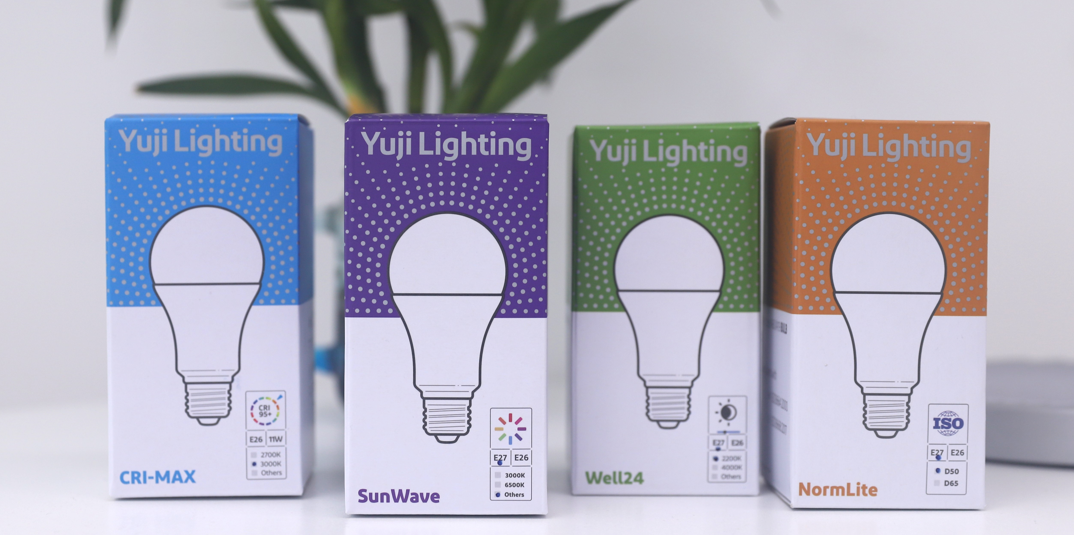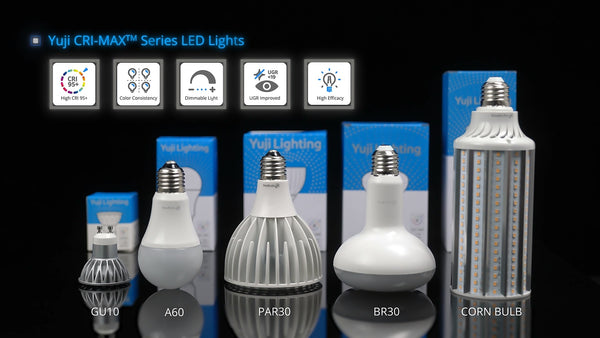
The Ultimate LED Bulb Buying Guide: Decoding Package Labels and Making Informed Choices1
In recent years, LED bulbs have become the preferred choice for energy-efficient lighting solutions. With their longevity, and diverse options, LED bulbs have revolutionized the way we illuminate our homes and businesses. In this blog, we will discuss how to read the LED light bulb label on a package box. The label contains vital information that can help you determine whether the LED bulb is the right one for your needs.
Understanding the Basics of LED Bulbs:
Before delving into package labels, it's crucial to grasp the fundamental aspects of LED bulbs. Unlike traditional incandescent and fluorescent bulbs, LEDs (Light Emitting Diodes) use semiconductor technology to produce light, resulting in significantly lower energy consumption and longer lifespans. Normally, the LED often has more than 2,5000 hours while the fluorescent has 10,000 hours. And the incandescent, only 1000 hours.
When choosing an LED source for your home, you need to consider a few key features which are normally indicated on the package label:
- Bulb Shape and Size
- Base Type
- Color Temperature (Kelvin)
- Lumens (Brightness)
- Power and Wattage Equivalence
- Light Quality Parameter: CRI R9 and TM30 CQS…
- Dimmability (Dimming mode)
- Beam Angle
- Lifespan and Warranty
-
Specific Features and Functions

- Bulb Shape and Size
The first thing to look for on the label is the type of LED bulb. There are several different types of LED bulbs, including A-shape, PAR, BR, and MR. Each type of LED bulb has different characteristics and uses. A-shape bulbs are typically used for general lighting purposes, while PAR and BR bulbs are commonly used for directional lighting. MR bulbs are used for accent lighting, such as highlighting artwork or architectural features.
LED bulbs come in various shapes and sizes, catering to different lighting needs and fixtures. Here's an introduction to some common shapes and sizes:
A19 (A60): This is one of the most common shapes, resembling a traditional incandescent bulb. It's spherical with a medium (E26/E27) base and is typically used for general lighting in lamps, ceiling fixtures, and wall sconces.

BR30: This bulb has a bulged reflector (BR) shape with a diameter of 3.75 inches. It's commonly used for floodlighting and recessed lighting indoors, especially in areas like kitchens and bathrooms.
PAR30/38: Another bulb with a parabolic aluminized reflector (PAR) shape, with a diameter of 3.75/4.75 inches. PAR38 bulbs are often used for outdoor floodlighting, security lighting, and highlighting architectural features.
Tube/T8: These bulbs have a tubular shape and are commonly used in commercial and industrial settings for overhead lighting. They come in different lengths, with the T8 size being one of the most common for LED replacements.
MR16: Typically used in track lighting, display lighting, and landscape lighting, MR16 bulbs have a multifaceted reflector (MR) shape and a diameter of 2 inches. They provide directional lighting and come in various beam angles.
Filament: These bulbs feature LED filaments arranged to mimic the look of traditional incandescent filaments. They come in various shapes like ST64, G80, and A60, offering a vintage aesthetic while providing energy-efficient lighting.

These are just a few examples, and there are many other shapes and sizes available to suit different applications and preferences in LED lighting. Make sure you have selected the proper bulb for your application. For example, if you're using a recessed lighting fixture, consider the diameter and length of the bulb to ensure it fits snugly without protruding.
For more details please check the blog: Introducing Typical Bulb Shapes and Sizes
https://store.yujiintl.com/blogs/all-about-led-lights/introducing-typical-bulb-shapes-and-sizes
- Base Type
Choosing the right LED bulb base is essential to ensure compatibility with your fixtures and sockets. Common fixtures include lamps, ceiling lights, track lights, recessed lights, and outdoor lighting. Some fixtures may have specific requirements or restrictions regarding the type of base they can accommodate. For example, certain track lighting systems may only accept GU10 bulbs, while some energy-efficient fixtures may require GU24 bulbs for compliance.
E26/E27: This is one of the most common base types for LED bulbs. The "E" stands for Edison screw, and the number indicates the diameter of the screw thread in millimeters (26mm for E26 and 27mm for E27). These bulbs are used in a wide range of fixtures such as lamps, ceiling lights, and wall sconces.
GU10: GU10 bulbs have a bi-pin twist and lock base. They are commonly used in track lighting, recessed lighting, and some pendant fixtures. The "GU" stands for "twist and lock" in German, and the "10" refers to the distance in millimeters between the pins.
MR16: MR16 bulbs have a bi-pin base and are commonly used in track lighting, landscape lighting, and display lighting. They are available in both low-voltage and line-voltage versions, with the low-voltage types requiring a transformer.
T8/T12: These are tube-shaped bulbs commonly used in fluorescent tube replacements. They come with either medium bi-pin bases (T8) or medium single-pin bases (T12) and are often used in commercial and industrial settings for overhead lighting.
B22/Bayonet: Commonly used in the UK and some other regions, B22 bulbs have a bayonet cap base. They are often found in ceiling fixtures, table lamps, and floor lamps.

These are just a few examples of LED bulb base types, and there are many others available to suit different fixtures and applications. Check the specifications provided by the bulb manufacturer to confirm compatibility. Pay attention to factors such as voltage requirements, socket size, and mounting mechanism.

- Color Temperature (Kelvin)
The color temperature of the LED bulb is another important factor to consider.
Color temperature is measured in Kelvin (K) and refers to the color of the light produced by the bulb. LED bulbs with lower color temperatures (2700K-3000K) produce warm, yellowish light, while bulbs with higher color temperatures (5000K-6500K) produce cool, bluish light. The color temperature of the LED bulb can affect the mood and ambiance of a room. For example, warm light may be more suitable for cozy spaces like bedrooms or living rooms, while cool light may be more appropriate for task-oriented areas such as a kitchen or home office.

Warm White (2700K-3000K): LED bulbs with warm white CCTs emit a cozy and inviting light similar to traditional incandescent bulbs. They create a warm ambiance ideal for residential spaces like living rooms, bedrooms, and dining areas, as well as hospitality environments.
Soft White (3000K-3500K): Soft white LED bulbs offer a slightly cooler tone than warm white but still provide a comfortable and inviting glow. They are suitable for general lighting in residential and commercial settings, including bathrooms, and retail spaces.
Neutral White (3500K-4000K): Neutral white LED bulbs produce a balanced light that closely resembles natural daylight. They offer crisp and clear illumination, making them suitable for task lighting in offices, workshops, and study areas where visual accuracy is important.
Cool White (4000K-5000K): LED bulbs with cool white CCTs emit a bright and energizing light similar to daylight. They are ideal for spaces where high visibility and concentration are required, such as offices, retail stores, hospitals, and educational facilities.
Daylight (6500K): Daylight LED bulbs provide a bright and refreshing light that closely mimics natural daylight. They are often used in spaces where maximum visibility and color accuracy are critical, such as art studios, hospitals, and industrial facilities.
Tunable White: Some LED bulbs offer tunable white technology, allowing users to adjust the CCT of the light output according to their preferences or specific lighting needs. This feature is commonly found in smart lighting systems and allows for dynamic control over the ambiance of a space.
When choosing LED bulbs, consider the CCT that best complements the function and atmosphere of the intended space. Whether you prefer a warm and cozy ambiance or a bright and refreshing illumination, LED bulbs offer a wide range of CCT options to suit diverse lighting preferences and requirements.
- Lumens (Brightness)
Lumen (lm) is the unit of measurement used to quantify the total visible light output produced by a light source, regardless of its direction. The higher the lumens, the brighter the light. Use lumens as a guide to match the bulb's brightness to your specific lighting needs.

When selecting LED bulbs based on lumen output, consider the specific lighting needs and requirements of the intended application. For example, task lighting may require higher lumen output to ensure adequate visibility and clarity, while ambient or decorative lighting may benefit from softer and more subdued illumination.
LED technology offers excellent energy efficiency, allowing LED bulbs to produce high-lumen output while consuming less energy compared to traditional incandescent or fluorescent bulbs. This means that LED bulbs can deliver bright illumination while reducing electricity consumption and operating costs.
LED bulb packaging typically includes information on lumen output, providing consumers with essential details to make informed decisions when purchasing bulbs. Pay attention to lumen values and compare them across different products to choose the most suitable LED bulbs for your lighting needs.
|
|
LED |
Fluorescent |
Incandescent |
|
Lifespan |
25,000 hours |
10,000 hours |
1000 hours |
|
Watt |
11W(10-15W) |
20W (15-20W) |
75W |
|
Lumens |
1100lm |
1100lm |
1100lm |
|
lm/w |
100 |
55 |
15 |

Leave a comment